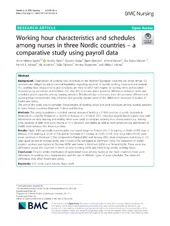| dc.contributor.author | Garde, Anne Helene | |
| dc.contributor.author | Harris, Anette | |
| dc.contributor.author | Vedaa, Øystein | |
| dc.contributor.author | Bjorvatn, Bjørn | |
| dc.contributor.author | Hansen, Johnni | |
| dc.contributor.author | Hansen, Åse Marie | |
| dc.contributor.author | Kolstad, Henrik A. | |
| dc.contributor.author | Koskinen, Aki | |
| dc.contributor.author | Pallesen, Ståle | |
| dc.contributor.author | Ropponen, Annina | |
| dc.contributor.author | Härmä, Mikko | |
| dc.date.accessioned | 2020-03-31T12:08:44Z | |
| dc.date.available | 2020-03-31T12:08:44Z | |
| dc.date.issued | 2019-03-28 | |
| dc.Published | Garde AH, Harris A, Vedaa Ø, Bjorvatn B, et al. Working hour characteristics and schedules among nurses in three Nordic countries – a comparative study using payroll data. BMC Nursing. 2019;18:12 | eng |
| dc.identifier.issn | 1472-6955 | |
| dc.identifier.uri | https://hdl.handle.net/1956/21639 | |
| dc.description.abstract | Background: Organisation of working hour schedules in the Northern European countries are rather similar. EU countries are obliged to adopt national legislation regarding duration of weekly working hours and rest periods. Yet, working hour characteristics and schedules are likely to differ with respect to starting times and duration depending e.g. on culture and tradition. Yet, very little is known about potential differences between shifts and schedules across countries among nursing personel. This knowledge is relevant, since the potential differences in working hour characteristics may influence and possibly explain some of the differences observed in studies of health and safety. The aim of the study was to compare characteristics of working hours and work schedules among nursing personel in three Nordic countries: Denmark, Finland and Norway. Methods: The study populations included nursing personnel holding a ≥ 50% position at public hospitals in Denmark (n = 63,678), Finland (n = 18,257) or Norway (n = 1538) in 2013. Objective payroll based registry data with information on daily starting and ending times were used to compare working hour characteristics e.g. starting time, duration of shift, and quick returns (< 11 h between two shifts), as well as work schedules e.g. permanent or 3-shift work between the three countries. Results: Night shifts generally started earlier and lasted longer in Finland (10–11 h starting at 20:00–22:59) than in Norway (10 h starting at 21:00–21:59) and in Denmark (8 h starting at 23:00–23:59). Very long shifts (≥12 h) were more common in Denmark (12%) compared to Finland (8%) and Norway (3%). More employees had many (> 13/year) quick returns in Norway (64%) and Finland (47%) compared to Denmark (16%). The frequency of 3-shift rotation workers was highest in Norway (41%) and lower in Denmark (22%) and Finland (22%). There were few differences across the countries in terms of early morning shifts and (very) long weekly working hours. Conclusion: Despite similar distribution of operational hours among nurses in the three countries, there were differences in working hour characteristics and the use of different types of work schedules. The observed differences may affect health and safety. | en_US |
| dc.language.iso | eng | eng |
| dc.publisher | BioMed Central | eng |
| dc.rights | Attribution CC BY | eng |
| dc.rights.uri | http://creativecommons.org/licenses/by/4.0/ | eng |
| dc.subject | Shift work | eng |
| dc.subject | Quick returns | eng |
| dc.subject | Night work | eng |
| dc.title | Working hour characteristics and schedules among nurses in three Nordic countries – a comparative study using payroll data | eng |
| dc.type | Peer reviewed | |
| dc.type | Journal article | |
| dc.date.updated | 2019-11-26T09:24:20Z | |
| dc.description.version | publishedVersion | |
| dc.rights.holder | Copyright 2019 The Author(s) | eng |
| dc.identifier.doi | https://doi.org/10.1186/s12912-019-0332-4 | |
| dc.identifier.cristin | 1716326 | |
| dc.source.journal | BMC Nursing | |
| dc.relation.project | Nordforsk: 74809 | |

